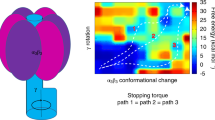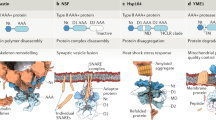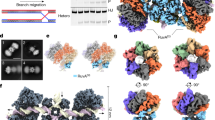Abstract
Hexameric ring-shaped ATPases of the AAA + (for ATPases associated with various cellular activities) superfamily power cellular processes in which macromolecular structures and complexes are dismantled or denatured, but the mechanisms used by these machine-like enzymes are poorly understood. By covalently linking active and inactive subunits of the ATPase ClpX to form hexamers, here we show that diverse geometric arrangements can support the enzymatic unfolding of protein substrates and translocation of the denatured polypeptide into the ClpP peptidase for degradation. These studies indicate that the ClpX power stroke is generated by ATP hydrolysis in a single subunit, rule out concerted and strict sequential ATP hydrolysis models, and provide evidence for a probabilistic sequence of nucleotide hydrolysis. This mechanism would allow any ClpX subunit in contact with a translocating polypeptide to hydrolyse ATP to drive substrate spooling into ClpP, and would prevent stalling if one subunit failed to bind or hydrolyse ATP. Energy-dependent machines with highly diverse quaternary architectures and molecular functions could operate by similar asymmetric mechanisms.
This is a preview of subscription content, access via your institution
Access options
Subscribe to this journal
Receive 51 print issues and online access
$199.00 per year
only $3.90 per issue
Buy this article
- Purchase on Springer Link
- Instant access to full article PDF
Prices may be subject to local taxes which are calculated during checkout




Similar content being viewed by others
References
Gottesman, S. Proteases and their targets in Escherichia coli. Annu. Rev. Genet. 30, 465–506 (1996)
Neuwald, A. F., Aravind, L., Spouge, J. L. & Koonin, E. V. AAA + : A class of chaperone-like ATPases associated with the assembly, operation, and disassembly of protein complexes. Genome Res. 9, 27–43 (1999)
Langer, T. AAA proteases: cellular machines for degrading membrane proteins. Trends Biochem. Sci. 25, 247–251 (2000)
Ogura, T. & Wilkinson, A. J. AAA + superfamily ATPases: common structure—diverse function. Genes Cells 6, 575–597 (2001)
Gottesman, S. Proteolysis in bacterial regulatory circuits. Annu. Rev. Cell Dev. Biol. 19, 565–587 (2003)
Sauer, R. T. et al. Sculpting the proteome with AAA + proteases and disassembly machines. Cell 119, 9–18 (2004)
Pickart, C. M. & Cohen, R. E. Proteasomes and their kin: proteases in the machine age. Nature Rev. Mol. Cell Biol. 5, 177–187 (2004)
Grimaud, R., Kessel, M., Beuron, F., Steven, A. C. & Maurizi, M. R. Enzymatic and structural similarities between the Escherichia coli ATP-dependent proteases, ClpXP and ClpAP. J. Biol. Chem. 273, 12476–12481 (1998)
Kim, Y. I., Burton, R. E., Burton, B. M., Sauer, R. T. & Baker, T. A. Dynamics of substrate denaturation and translocation by the ClpXP degradation machine. Mol. Cell 5, 639–648 (2000)
Singh, S. K., Grimaud, R., Hoskins, J. R., Wickner, S. & Maurizi, M. R. Unfolding and internalization of proteins by the ATP-dependent proteases ClpXP and ClpAP. Proc. Natl Acad. Sci. USA 97, 8898–8903 (2000)
Burton, R. E., Siddiqui, S. M., Kim, Y. I., Baker, T. A. & Sauer, R. T. Effects of protein stability and structure on substrate processing by the ClpXP unfolding and degradation machine. EMBO J. 20, 3092–3100 (2001)
Flynn, J. M. et al. Overlapping recognition determinants within the ssrA degradation tag allow modulation of proteolysis. Proc. Natl Acad. Sci. USA 98, 10584–10589 (2001)
Kenniston, J. A., Baker, T. A., Fernandez, J. M. & Sauer, R. T. Linkage between ATP consumption and mechanical unfolding during the protein processing reactions of a AAA + degradation machine. Cell 114, 511–520 (2003)
Bolon, D. N., Grant, R. A., Baker, T. A. & Sauer, R. T. Nucleotide-dependent substrate handoff from the SspB adaptor to the AAA + ClpXP protease. Mol. Cell 16, 343–350 (2004)
Hersch, G. L., Burton, R. E., Bolon, D. N., Baker, T. A. & Sauer, R. T. Asymmetric interactions of ATP with the AAA + ClpX6 unfoldase: allosteric control of a protein machine. Cell 121, 1017–1027 (2005)
Hingorani, M. M., Washington, M. T., Moore, K. C. & Patel, S. S. The dTTPase mechanism of T7 DNA helicase resembles the binding change mechanism of the F1-ATPase. Proc. Natl Acad. Sci. USA 94, 5012–5017 (1997)
Stitt, B. L. & Xu, Y. Sequential hydrolysis of ATP molecules bound in interacting catalytic sites of Escherichia coli transcription termination protein Rho. J. Biol. Chem. 273, 26477–26486 (1998)
Stitt, B. L. Escherichia coli transcription termination factor Rho binds and hydrolyzes ATP using a single class of three sites. Biochemistry 40, 2276–2281 (2001)
Bochtler, M. et al. The structures of HsIU and the ATP-dependent protease HsIU–HsIV. Nature 403, 800–805 (2000)
Singleton, M. R., Sawaya, M. R., Ellenberger, T. & Wigley, D. B. Crystal structure of T7 gene 4 ring helicase indicates a mechanism for sequential hydrolysis of nucleotides. Cell 101, 589–600 (2000)
Zalk, R. & Shoshan-Barmatz, V. ATP-binding sites in brain p97/VCP (valosin-containing protein), a multifunctional AAA ATPase. Biochem. J. 374, 473–480 (2003)
Hishida, T., Han, Y. W., Fujimoto, S., Iwasaki, H. & Shinagawa, H. Direct evidence that a conserved arginine in RuvB AAA + ATPase acts as an allosteric effector for the ATPase activity of the adjacent subunit in a hexamer. Proc. Natl Acad. Sci. USA 101, 9573–9577 (2004)
Boyer, P. D. The ATP synthase—a splendid molecular machine. Annu. Rev. Biochem. 66, 717–749 (1997)
Wojtyra, U. A., Thibault, G., Tuite, A. & Houry, W. A. The N-terminal zinc binding domain of ClpX is a dimerization domain that modulates the chaperone function. J. Biol. Chem. 278, 48981–48990 (2003)
Kim, D. Y. & Kim, K. K. Crystal structure of ClpX molecular chaperone from Helicobacter pylori. J. Biol. Chem. 278, 50664–50670 (2003)
Joshi, S. A., Hersch, G. L., Baker, T. A. & Sauer, R. T. Communication between ClpX and ClpP during substrate processing and degradation. Nature Struct. Mol. Biol. 11, 404–411 (2004)
Dougan, D. A., Reid, B. G., Horwich, A. L. & Bukau, B. ClpS, a substrate modulator of the ClpAP machine. Mol. Cell 9, 673–683 (2002)
Levchenko, I., Seidel, M., Sauer, R. T. & Baker, T. A. A specificity-enhancing factor for the ClpXP degradation machine. Science 289, 2354–2356 (2000)
Kenniston, J. A., Baker, T. A. & Sauer, R. T. Partitioning between unfolding and release of native domains during ClpXP degradation determines substrate selectivity and partial processing. Proc. Natl Acad. Sci. USA 102, 1390–1395 (2005)
Lee, C., Schwartz, M. P., Prakash, S., Iwakura, M. & Matouschek, A. ATP-dependent proteases degrade their substrates by processively unraveling them from the degradation signal. Mol. Cell 7, 627–637 (2001)
Gai, D., Zhao, R., Li, D., Finkielstein, C. V. & Chen, X. S. Mechanisms of conformational change for a replicative hexameric helicase of SV40 large tumour antigen. Cell 119, 47–60 (2004)
Lee, S. Y. et al. Regulation of the transcriptional activator NtrC1: structural studies of the regulatory and AAA + ATPase domains. Genes Dev. 17, 2552–2563 (2003)
Toth, E. A., Li, Y., Sawaya, M. R., Cheng, Y. & Ellenberger, T. The crystal structure of the bifunctional primase-helicase of bacteriophage T7. Mol. Cell 12, 1113–1123 (2003)
Skordalakes, E. & Berger, J. M. Structure of Rho transcription terminator: mechanism of mRNA recognition and helicase loading. Cell 114, 135–146 (2003)
Schwacha, A. & Bell, S. P. Interactions between two catalytically distinct MCM subgroups are essential for coordinated ATP hydrolysis and DNA replication. Mol. Cell 8, 1093–1104 (2001)
Bowman, G. D., Goedken, E. R., Kazmirski, S. L., O'Donnell, M. & Kuriyan, J. DNA polymerase clamp loaders and DNA recognition. FEBS Lett. 579, 863–867 (2005)
Sakato, M. & King, S. M. Design and regulation of the AAA + microtubule motor dynein. J. Struct. Biol. 146, 58–71 (2004)
Acknowledgements
We thank S. Bell, D. Bolon, R. Burton, P. Chien, C. Farrell, G. Hersch, J. Kenniston, K. McGinness, S. Moore, F. Solomon and K. Wang for help and discussions. T.A.B. is an employee of the Howard Hughes Medical Institute. This work was supported by grants from the NIH.
Author information
Authors and Affiliations
Corresponding author
Ethics declarations
Competing interests
Reprints and permissions information is available at npg.nature.com/reprintsandpermissions. The authors declare no competing financial interests.
Rights and permissions
About this article
Cite this article
Martin, A., Baker, T. & Sauer, R. Rebuilt AAA + motors reveal operating principles for ATP-fuelled machines. Nature 437, 1115–1120 (2005). https://doi.org/10.1038/nature04031
Received:
Accepted:
Issue Date:
DOI: https://doi.org/10.1038/nature04031
This article is cited by
-
A closed translocation channel in the substrate-free AAA+ ClpXP protease diminishes rogue degradation
Nature Communications (2023)
-
Extreme parsimony in ATP consumption by 20S complexes in the global disassembly of single SNARE complexes
Nature Communications (2021)
-
Acoustic biosensors for ultrasound imaging of enzyme activity
Nature Chemical Biology (2020)
-
An engineered enzyme that targets circulating lactate to alleviate intracellular NADH:NAD+ imbalance
Nature Biotechnology (2020)
-
The molecular principles governing the activity and functional diversity of AAA+ proteins
Nature Reviews Molecular Cell Biology (2020)
Comments
By submitting a comment you agree to abide by our Terms and Community Guidelines. If you find something abusive or that does not comply with our terms or guidelines please flag it as inappropriate.



